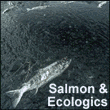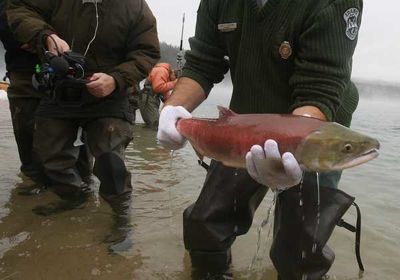forum
library
tutorial
contact

Central Idaho Sockeye Return Down;
Could be Due to Low Smolt Survival in 2010 Migration
by Staff
Columbia Basin Bulletin, October 26, 2012
|
the film forum library tutorial contact |

|
Central Idaho Sockeye Return Down;
by Staff
|
 Adult sockeye salmon returns to central Idaho's high country flagged this year as compared to a recent series of modern-time annual records, but the 2012 run still ranks as the sixth best since a hatchery captive broodstock program was launched in the early 1990s to save a species near extinction.
Adult sockeye salmon returns to central Idaho's high country flagged this year as compared to a recent series of modern-time annual records, but the 2012 run still ranks as the sixth best since a hatchery captive broodstock program was launched in the early 1990s to save a species near extinction.
Idaho Department of Fish and Game officials report that a total of 243 anadromous sockeye -- spawners from the Pacific Ocean -- were trapped this year at Redfish Lake Creek and near Sawtooth Fish Hatchery. Redfish Lake Creek flows out of Redfish Lake and into the Salmon River in Idaho's Sawtooth Valley. The hatchery is located near Stanley downstream on the Salmon River.
With the run sapped, the Redfish Lake Creek trap was removed on Oct. 17 and the Sawtooth Fish Hatchery Trap was shut down on Sept. 21. A total of 470 sockeye spawners were counted in 2012 passing the lower Snake River's Lower Granite Dam in southeast Washington. During their return from saltwater the fish swim about 900 miles, while gaining 6,500 feet in elevation, up the Columbia, Snake and Salmon rivers. Lower Granite is about 400 river miles from the sockeye spawners' destination. The last sockeye counted this year at Lower Granite was Sept. 29.
In all, 107 sockeye were trapped this year at Redfish Lake Creek and 136 were trapped at Sawtooth Fish Hatchery.
Of the 243 anadromous sockeye trapped, 173 were released to Redfish Lake so that they could spawn naturally.
An additional 625 adult fish were released into Redfish Lake this year that have been raised in captivity at either IDFG's Eagle Hatchery or NOAA Fisheries Service's Manchester Research Station in Washington's western Puget Sound.
The other 70 anadromous sockeye were incorporated into the captive broodstock at the IDFG's Eagle Fish Hatchery near Boise.
The Snake River Sockeye Salmon Captive Broodstock Program, a multi-agency and tribal effort started in May 1991, was initiated to protect population genetic structure and to prevent the further decline of Idaho sockeye salmon. The program also produces eggs and fish to reintroduce to the habitat to increase population numbers.
Idaho Fish and Game is working with the Bonneville Power Administration, which funds much of the program, to increase the number of smolts the program releases. Project cooperators include representatives from IDFG, NOAA Fisheries, Oregon Department of Fish and Wildlife, Shoshone-Bannock Tribes and the BPA.
Between 1991 and 1998, only 16 wild sockeye salmon returned to Idaho. All of these adults were incorporated into the captive breeding program and spawned at the Eagle Fish Hatchery. The Snake River sockeye were in 1991 listed as endangered under the federal Endangered Species Act.
The program was initiated to conserve and rebuild the Redfish Lake sockeye salmon stock in the Sawtooth Valley of central Idaho. Historically, five Sawtooth Valley lakes -- Alturas, Pettit, Redfish, Stanley and Yellowbelly -- supported sockeye salmon. Restoration efforts today are focused on Alturas, Pettit, and Redfish lakes.
Between 1991 and1998, only 16 wild sockeye totalreturned to Idaho. Between 1999 and 2007, 355 hatchery produced adult sockeye salmon returned to the Sawtooth Valley. Over the previous 14 years, only 77 natural-origin sockeye had returned.
In recent years, the number of full term smolts produced by the program has increased to approximately 200,000 annually. As a result of the increased smolt production, the number of anadromous adults returning to the Stanley Basin has also increased:
Survival of smolts in 2010 from central Idaho down to Lower Granite Dam "was the lowest we've ever observed," Peterson said. In this case cold water, and relatively low flows, during the annual early May smolt release, may have caused problems. Water temperatures were at least 10 degrees lower than the average for that time of year and flows in the Yankee Fork of the Salmon were 876 cubic feet per second during the May 1-15 period, down more than 900 from the recent average for the period of 1.8 kcfs. Water temperatures were about 40 degrees as compared to the normal early May temperature of 50 degrees.
"It was almost like they stopped," Peterson said the young fish. Their transit time from the valley down to Lower Granite Dam was two days slower than average.
Smolt survival in 2010 to Lower Granite was estimated to be 42,000 out of 207,000 released upstream.
"I expect it to bounce back," Peterson of projections for the 2012(2013 and 2014) return. Many factors, including ocean rearing conditions, affect smolt-to-adult returns, but last year's brood got off to a good start. Smolt survival from the Sawtooth Valley to Lower Granite in 2011 was 77 percent as compared to 21 percent in 2010. Adult returns from that 2011outmigration will return, in large part, in 2013.
Related Pages:
Count the Fish by Government Accounting Office, GAO-02-612, Salmon and Steelhead Recovery Efforts
learn more on topics covered in the film
see the video
read the script
learn the songs
discussion forum
